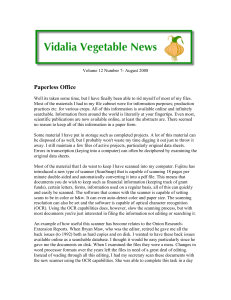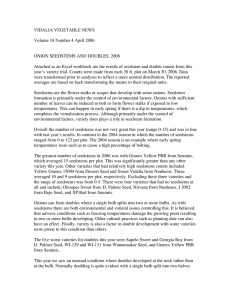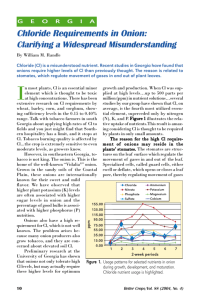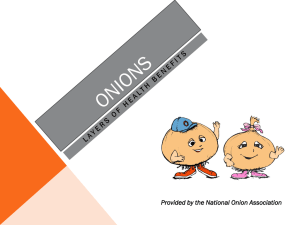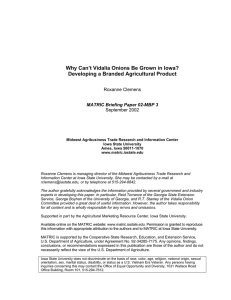VIDALIA VEGETABLE NEWS Volume 11 Number 2 March 2007
advertisement
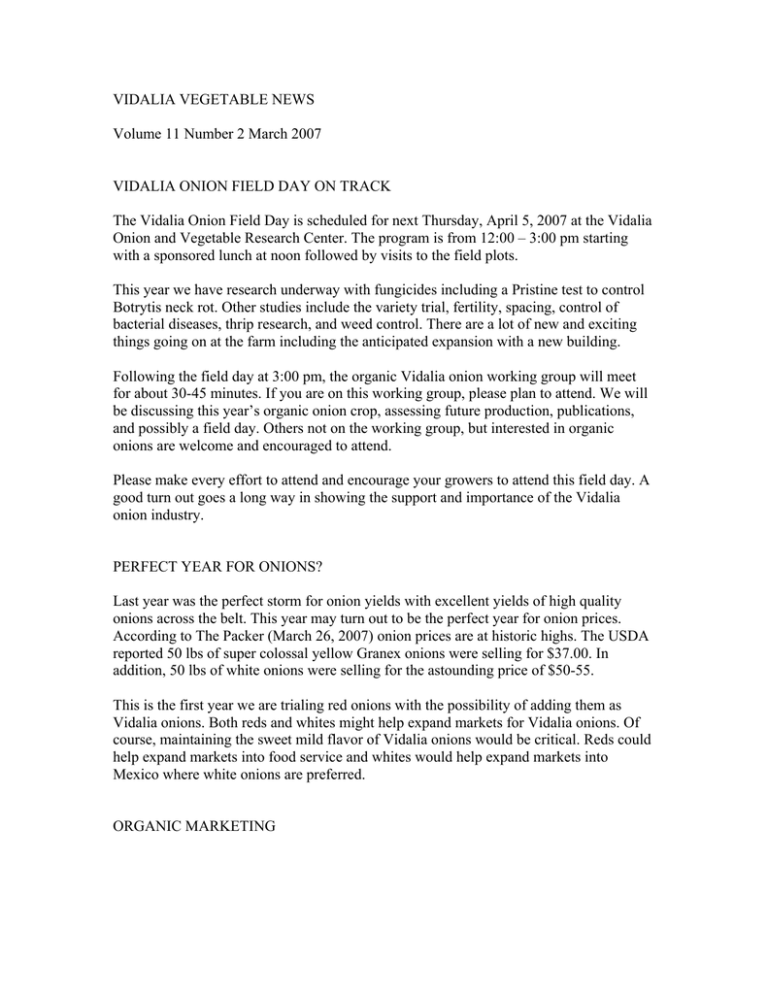
VIDALIA VEGETABLE NEWS Volume 11 Number 2 March 2007 VIDALIA ONION FIELD DAY ON TRACK The Vidalia Onion Field Day is scheduled for next Thursday, April 5, 2007 at the Vidalia Onion and Vegetable Research Center. The program is from 12:00 – 3:00 pm starting with a sponsored lunch at noon followed by visits to the field plots. This year we have research underway with fungicides including a Pristine test to control Botrytis neck rot. Other studies include the variety trial, fertility, spacing, control of bacterial diseases, thrip research, and weed control. There are a lot of new and exciting things going on at the farm including the anticipated expansion with a new building. Following the field day at 3:00 pm, the organic Vidalia onion working group will meet for about 30-45 minutes. If you are on this working group, please plan to attend. We will be discussing this year’s organic onion crop, assessing future production, publications, and possibly a field day. Others not on the working group, but interested in organic onions are welcome and encouraged to attend. Please make every effort to attend and encourage your growers to attend this field day. A good turn out goes a long way in showing the support and importance of the Vidalia onion industry. PERFECT YEAR FOR ONIONS? Last year was the perfect storm for onion yields with excellent yields of high quality onions across the belt. This year may turn out to be the perfect year for onion prices. According to The Packer (March 26, 2007) onion prices are at historic highs. The USDA reported 50 lbs of super colossal yellow Granex onions were selling for $37.00. In addition, 50 lbs of white onions were selling for the astounding price of $50-55. This is the first year we are trialing red onions with the possibility of adding them as Vidalia onions. Both reds and whites might help expand markets for Vidalia onions. Of course, maintaining the sweet mild flavor of Vidalia onions would be critical. Reds could help expand markets into food service and whites would help expand markets into Mexico where white onions are preferred. ORGANIC MARKETING I attended Georgia Organics conference earlier this month in Douglas. They had the largest attendance they have ever had. In addition, Commissioner of Agriculture Tommy Irvin was able to attend and speak at the conference. At the conference, I had the opportunity to attend the marketing session with Alex Rilko who is a buyer with Whole Foods. Whole Foods is the largest supermarket chain for organic produce and they are looking for suppliers. Whether you are a large or small grower, they are looking to do business with you. They are particularly interested in local supplies, which should help growers across the U.S. They do have some requirements for their suppliers. To start with, organic certification is going to go a long way with marketing to Whole Foods. To be set up in their system takes five days and they will need two weeks lead time before they can purchase your produce, so plan accordingly. You will probably want to contact them well in advance, perhaps even before you plant your crops to find out what they are looking for. They do require liability insurance of $1 million and $2 million if you grow mushrooms or sprouts. You will need to use new boxes or bags, meet USDA standards, use good clean pallets, wrap pallets, and handle produce with proper cooling and storage. Their payment policy is 14 to 30 days and pricing generally follows daily market prices. They like to lock in ad pricing and require a copy of the invoice at time of delivery. You may be able to sell to them even if you are not certified organic. Farms in transition to organic should check with Whole Foods. Other sustainable or environmentally friendly practices may be of interest to them as well, such as grass fed beef and pesticide free greenhouse tomatoes. If you are a local producer and have something particularly unusual for the region, Whole Foods may be interested. Heirloom varieties, unusual colors, etc. may also be of interest to Whole Foods. With any of this, you should contact them before committing resources to producing it. FROM MY DESK The weather has been particularly warm the last couple of days, however, today has been decidedly cooler. It has also been very dry, which has been good at keeping diseases in check. I hope to see all of you next week at the Vidalia Onion Field Day and do encourage your growers to attend. Thanks. Regards, <><><><><><><><><><><><><><><><><><><> George Boyhan, Ph.D. Associate Professor Extension Horticulturist-Vegetables Dept. of Horticulture University of Georgia Southeast Georgia Extension Center PO Box 8112 Nessmith-Lane Bldg. 2nd Flr. Statesboro, GA 30460 (912) 681-5639 Office (912) 681-0376 FAX (912) 682-3481 Mobile gboyhan@uga.edu <><><><><><><><><><><><><><><><><><><>
